李云国
开通时间:..
最后更新时间:..
Paper alert!
Yonghui published his first paper on the transport properties of FeSi at high pressure conditions in GRL.
Ab Initio Study of the Conductivities of B2 FeSi Under Core-Mantle Boundary Conditions
The ultra-low velocity zones (ULVZs) are anomalies at the core-mantle boundary (CMB), identified by their extremely low seismic velocities. However, their origins and conductive properties remain uncertain. Recent high-pressure experiments suggest that ULVZs may form from the B2 FeSi phase, crystallized from the outer core containing hydrogen and silicon. To better understand the conductive properties of B2 FeSi and its impact, we used first-principles calculations to determine its thermal and electrical conductivities under CMB conditions. Our results show that B2 FeSi has the highest thermal conductivity compared to mantle minerals. This makes ULVZs heat anomalies characterized by high thermal conductivity, high temperature, and high heat flux. Consequently, ULVZs could act as cooling spots at the top of the outer core, driving convection in the outer core and helping maintain the Earth's dynamo and geomagnetic field.

Comparison of the calculated thermal conductivity of B2 FeSi with literature data (De Koker et al., 2012; Dekura & Tsuchiya, 2019; Haigis et al., 2012; Hsieh et al., 2020; Pozzo et al., 2012; Wang et al., 2023; Xu et al., 2018; Zhang et al., 2022). Different marker shapes represent various studies, while colors denote distinct materials. Solid and hollow markers differentiate between different states.
A short introduction of this paper in Chinese can be found here.
Paper alert!
Peixue published her first paper on mineralogical study of bridgmanite in JGR: Solid Earth.
Ab Initio Evaluation of Point Defects in Bridgmanite Under Lower Mantle Conditions
This study investigated various types of point defects in bridgmanite (MgSiO3) under lower mantle conditions by ab initio calculation. The results show that among the possible point defects, oxygen vacancies have the highest concentration, which can reach up to 10−2 under the lower-mantle conditions. The abundant point defects in the lower mantle minerals are of great significance to the rheology of the lower mantle and the storage of trace elements like volatiles.
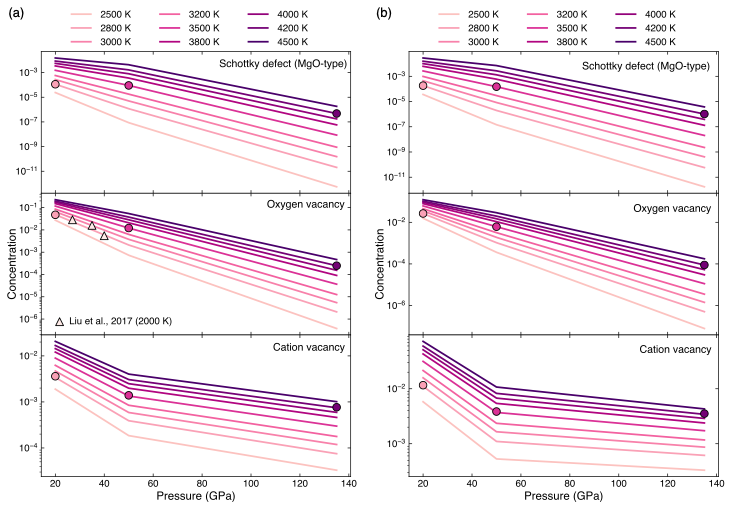
Defect concentrations at high temperatures under (a) MgO-saturated condition and (b) SiO2-saturated condition. The solid markers show the conditions under which the direct simulations were performed. The solid lines are interpolations as described in the text.
A short introduction of this paper in Chinese can be found here.
Paper alert!
A paper on water diffusion in silicate melt was published in Physical Review B from our group.
Dynamic bonding analysis of the water diffusion mechanism in silicate melts
Water diffusion in silicate melt is an essential process for understanding the transport properties and dehydration kinetics of silicate melt. However, the fast liquid dynamics and interconversion of hydrous species pose a substantial challenge to both experimental and theoretical studies of water diffusion. We developed a bonding analysis method to unambiguously identify stable and transition-state hydrous species, and obtained their characteristic diffusion coefficients from restrained ab initio molecular dynamics simulations. We find that the stable species include a hydroxyl group, molecular water, and a trace amount of hydronium. Proton is only a transition-state species, but proton hopping dominates the overall water diffusion with a contribution over 60%, primarily through triggering the rotational diffusion of the O–H bond. Namely, the coupling of proton hopping and O–H bond rotation leads to fast water diffusion. The uncovered mechanism enables the construction of a water diffusion model based purely on thermodynamics, and extrapolating this model to temperatures below 2000 K aligns well with experimental observations.
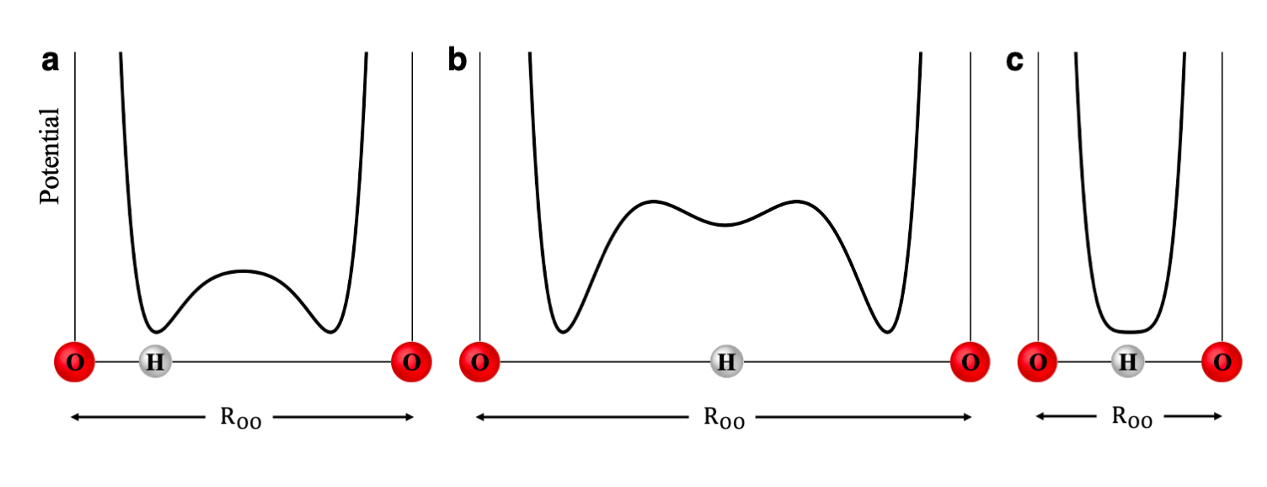
Figure: Schematic potential energy profiles indicating three possible types of configurations for one H between two O atoms. a H forms a hydroxyl group with the left O and a hydrogen bonding with the right O. b H forms two hydrogen bonding and stays as a stable isolated H between two O atoms. c H forms two covalent bonding with the two O atoms.
Welcome Hui Gao!
Dr. Hui Gao has joined us as a postdoc scientist. During her doctorate program, she conducted research on fluid thermodynamic modeling under the supervision of Professors and CAS fellow Xianhua Li and Zhigang Zhang at the Institute of Geology and Geophysics, CAS, ultimately earning a doctoral degree. Throughout this period, Hui gained extensive experience in thermodynamic theory, data analysis, parameter regression, and computational programming. In addition, Hui contributed to a national key research project, Properties and Effects of Supercritical Geological Fluids, where she was primarily responsible for developing thermodynamic models of supercritical geological fluids.
Cover image paper published in Science Bulletin
Yunguo and coauthors published their theoretical prediction on Martian core differentiation in a cover image paper in Science Bulletin.
The journal introduced this paper in their highlights:
Core-mantle differentiation is the most significant event in the history of rocky planets, involving massive redistribution of material. This process is pivotal for the long-term evolution of Mars, yet it is still not fully comprehended. By utilizing oxygen partitioning data derived from ab initio calculations and the most recent core composition constraints based on InSight seismic data, Li et al. have pinpointed the temperature and pressure conditions under which Martian core-mantle differentiation occurred. Their research indicates that the Martian core likely formed at a temperature exceeding 2440 K, under pressures spanning from 14 to 22 GPa. This study offers crucial parameters for understanding the origin, formation, and mantle geochemistry of Mars. The cover image vividly portrays the dynamic process of the core separating from a deep Martian magma ocean under extreme temperatures, providing a graphic representation of this crucial planetary event (see the article by Li et al.).

A short introduction of this paper in Chinese can be found here.
Group members attending Goldschmidt2024
Yunguo, Peixue and other members of HPHT petrology and mineralogy attended the Goldschmidt 2024 conference in Chicago.
Yunguo chaired a session titiled "Behavior and Effects of Volatiles in Melts and Fluids under Extreme Conditions" and another session titled "Tracing Solar System Evolution: From Dust to Core Formation".
Besides, Yunguo presented his recent work on water diffusion in silicate melt by a poster. The abstract is now online:
"Ab initio study of diffusion mechanism of water in silicate melt".
Peixue gave an oral presentation about point defects in bridgmanite under lower mantle conditions, and the abstract is also online:
"Ab initio evaluation of point defects in bridgmanite under lower mantle conditions".
Yonghui presenting at EGU Assembly 2024
Yonghui attended the EGU Assembly at Viena this year, presenting his work about The Conductivities of B2 FeSi under Core-mantle Boundary Conditions.

While the ultralow velocity zones (ULVZs) may hold key information about deep earth dynamics, their elusive state and origin remain as an enigma. Recently, high pressure experiments indicate that ULVZs may form from the B2 FeSi phase crystallized from the outer core containing H and Si. The possibility and impact of the B2 FeSi at the core mantle boundary (CMB) awaits further exploration. The conductivity of the B2 phase can be used to understand its role in deep mantle dynamics and also served as a test for its existence at the CMB. By using first-principles molecular dynamics and Kubo-Greenwood formula, we calculated the thermal and electrical conductivities of B2 FexSi1-x at 135 GPa up to 4,500 K. Our results show that at the CMB conditions, the thermal and electrical conductivities of B2 FeSi are significantly higher than other lower mantle minerals and the core. This would lead to a thermal anomaly region at the CMB, promote the core dynamo and enhance the cooling of the core if the ULVZs are dominated by B2 phase.
Welcome Hua Yang
Dr. Hua Yang has joined us as a postdoc scientist. Hua graduated from the Institute of Geochemistry, Chinese Academy of Sciences in 2023, under the supervision of Senior Research Scientist Feiwu Zhang. He is mainly engaged in the study of computational mineralogy and computational geochemistry. In recent years, he has studied the structure and properties of the deep earth through theoretical calculations, and published several SCI indexed papers in mainstream international magazines such as Geochemistry, Geophysics, Geosystems, and American Mineralogist.
Peixue and Yonghui attending meeting
Peixue Dou and Yonghui Huang (cosupervised) presented their studies at the “Habitable Earth - Geoscience for Sustainability” meeting held in Qingdao.
Peixue Dou gave a talk titled “Ab initio study of point defects in Bridgmanite”.
Yonghui Huang presented a talk titled “Ab initio study of the conductivities of B2 FeSi under core-mantle boundary conditions”.
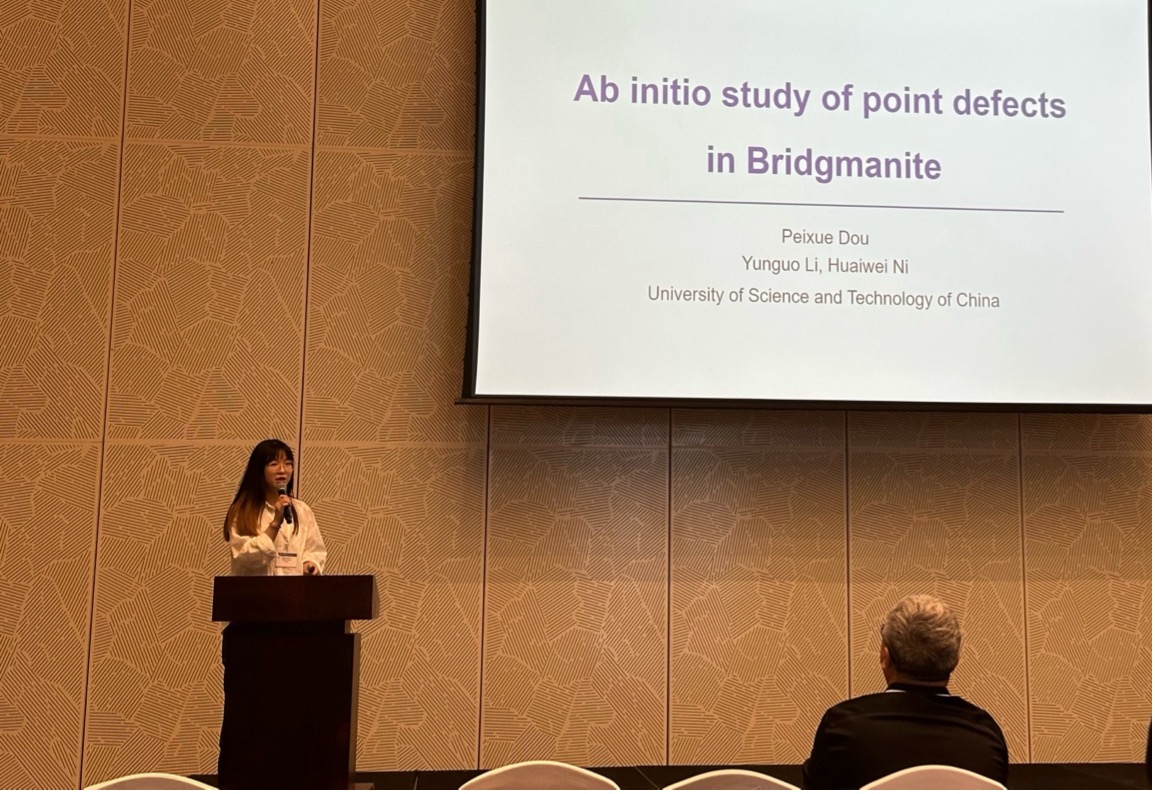
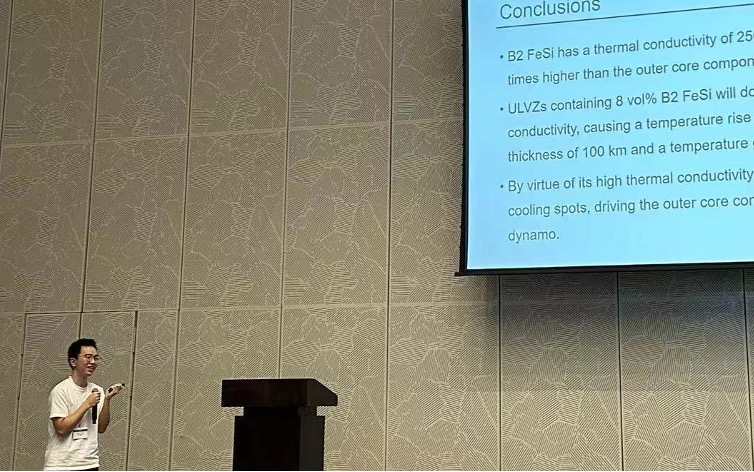
“Habitable Earth - Geoscience for Sustainability” is the first international geoscience conference to be held by Elsevier in China.
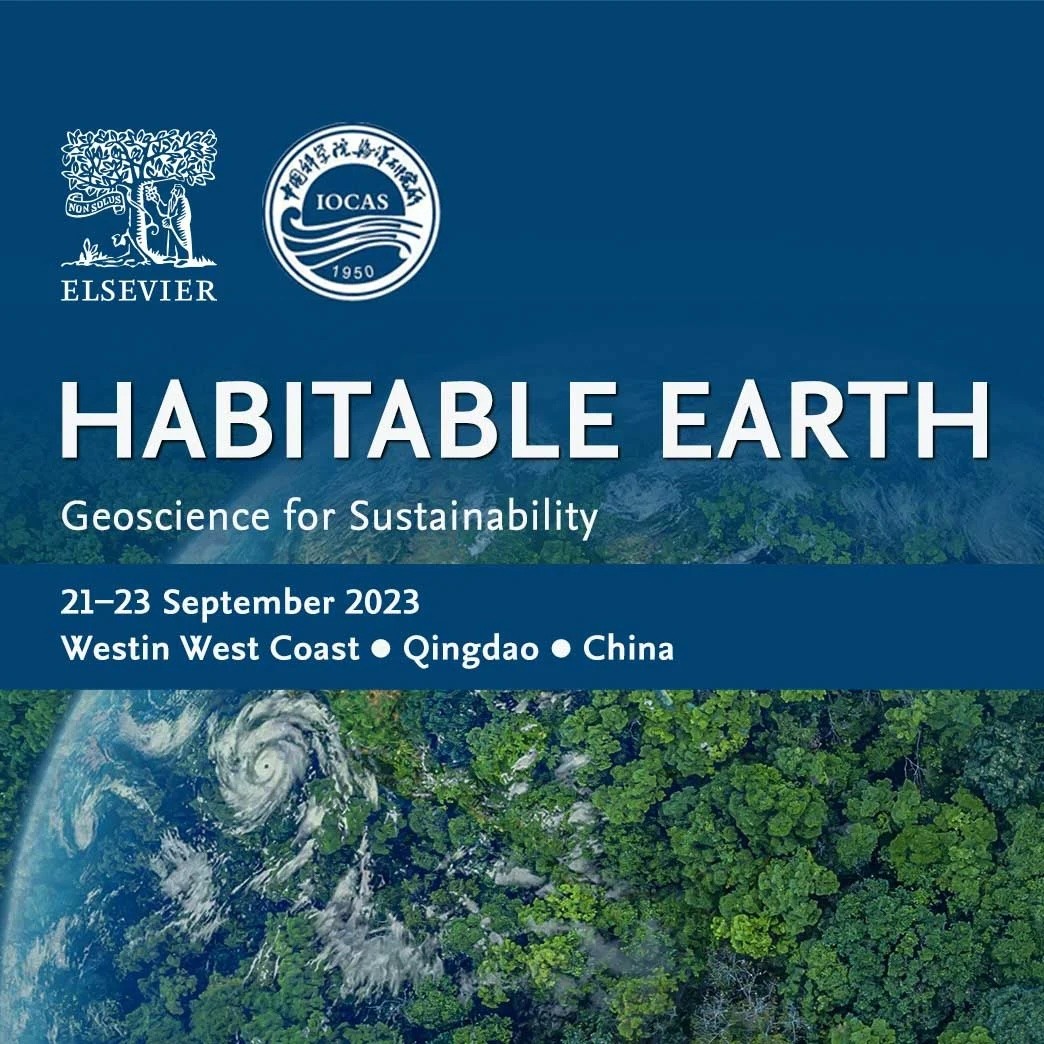
Lei Wan starting his research career
We welcome Lei Wang, who graduated from Hefei University of Technology this summer, to join us as a mater student and start his journey of science.
Yunguo attending Goldschmidt meeting
Yunguo attended the annual Goldschmidt meeting this year in Lyon, and presented a talk titled “Martian core-mantle differentiation conditions constrained by FeO partitioning”.

